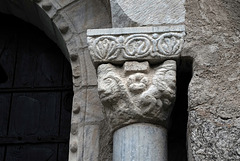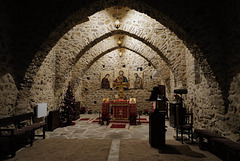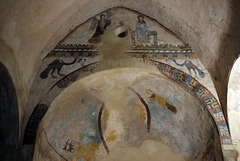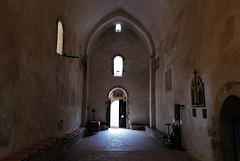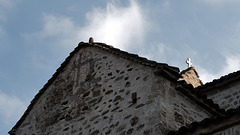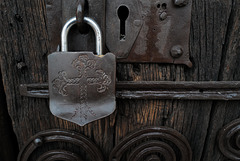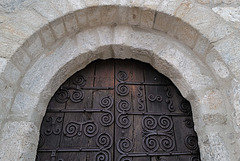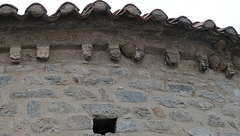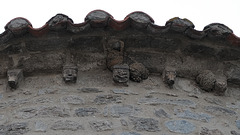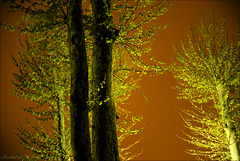
CATALUNYA
Santa Maria de Marcèvol L1030159
| |
|
Santa Maria de Marcèvol, HFF
| |
|
|
|
PIPs ABOVE
El priorat de Santa Maria de Marcèvol es troba a 560 metres d'altitud sobre un altiplà que domina la vall del Tet i mira cap al Canigó. Està situat en el poble de Marcèvol, que pertany a la comuna nord-catalana d'Arboçols, a la comarca del Conflent. Va ser declarat "monument històric" l'any 1840.
Està situat uns 200 metres separat al sud del poble de Marcèvol, lleugerament dessota seu.
El 1128 el bisbe d'Elna donà l'església i l'alou de Santa Maria als canonges del Sant Sepulcre, que hi fundaren un priorat abans del 1142, dependent del monestir de Santa Anna de Barcelona. Era l'única dependència d'aquest orde a la Catalunya del Nord. Vers el 1370 es va fortificar amb una gran muralla la casa i les dependències dels canonges, pròximes a la gran església de tres naus. El 1381 li fou unit el monestir doble de Sant Jaume d'Illa.
Segurament el terratrèmol de Catalunya de 1428 i sobretot la dissolució de l'orde pel papa l'any 1484 va fer que entrés en decadència, i s'unís, successivament, a Santa Maria de la Real de Perpinyà (1466) i a la comunitat de preveres de Vinçà (1476). En aquest temps foren refetes les voltes de l'església. N'ha desaparegut una absidiola, i l'absis principal és inutilitzat; la de migdia té restes d'una notable decoració mural romànica, amb un pantocràtor sobre fons d'estrelles.
Aquesta comunitat també va dedicar-se a l'organització de perdons a la Mare de Déu. Una tradició antiga hi associa un miracle de la mare d'un Papa, camí de Compostel·la, que seria sepultada a l'església parroquial. Llavors Marcèvol esdevingué un lloc que atreia centenars de pelegrins amb l'esperança d'obtenir grades o indulgències. Aquest és l'aplec més famós del Conflent, i cada 3 de maig a Marcèvol encara se celebra una missa.
Venut com a bé nacional a la Revolució, es convertí en explotació agrícola. L'edifici, classificat com a monument històric el segle xix, ha estat restaurat a partir dels anys 1970. Modernament s'hi ha instal·lat una comunitat laica, que té cura de la restauració de l'església (declarada monument nacional) i les dependències priorals.
ca.wikipedia.org/wiki/Santa_Maria_de_Marcèvol
+++++
The priory of Santa Maria de Marcèvol is located at an altitude of 560 metres on a plateau that overlooks the Tet valley and looks out over the Canigó. It is located in the town of Marcèvol, which belongs to the northeastern Catalan commune of Arboçols, in the region of El Conflent. It was declared a "historical monument" in 1840.
It is located about 200 meters south of the town of Marcèvol, and it has been declared a historical monument since 1840.
In 1128 the bishop of Elna gave the church and the wing of Santa Maria to the canons of the Sant Sepulcre, which was founded as a priory in 1142, dependent on the monastery of Santa Anna in Barcelona. It was the only dependency of this order in Northern Catalonia. Around 1370, the house and the canons' quarters were fortified with a large wall, close to the large church of three naus. In 1381 it became the double monastery of Sant Jaume d'Illa.
Surely the terratrèmol de Catalunya of 1428 and above all the dissolution of the order by the Pope in 1484 will enter into decline, and is united, successively, to Santa Maria de la Real de Perpinyà (1466) and the community of previsions of Vinçà (1476). In this time, the turns of the church were reflected. There is no longer an apsidal vault, and the main apsidal vault is no longer in use; the one with the migdia has the remains of a notable Romanesque wall decoration, with a pantocrator on a star base.
This community will also be dedicated to the organization of pardons to the Mother of God. An old tradition is associated with a miracle of the sea of a Pope, the way of Compostela, which would be buried in the parish church. Llavors Marcèvol gave birth to a place that dared hundreds of pilgrims with the hope of obtaining degrees or indulgences. This is the most famous application of the Conflent, and every 3rd of May a mass is celebrated in Marcèvol.
Coming as a national good to the Revolution, it is converted into a farm. The building, classified as a historical monument in the nineteenth century, has been restored since 1970. Nowadays, a secular community has been installed in the building, which is responsible for the restoration of the church (declared a national monument) and the priority rooms.
Santa Maria del Vilar
| |
|
|
Santa Maria del Vilar, HFF
| |
|
|
|
PIP ABOVE
In many ancient pre-Catholic traditions we find the serpent (or kind of mix of serpent and dragon as here) as guardian of sacred places. A troubling figure of Romanesque iconography, it possesses the versatility of its distant antecedents in the sacred art of ancient civilizations. It is not impossible that in Romanesque art it has retained its symbolism of the verticalization of the human and its unholy claim to divine privileges.
It is also a symbol of wisdom, of superior wisdom received from one or more gods.
At the time of Romanesque art, Celtic traditions were still alive and the artists who decorated the churches perpetuated this knowledge in cryptic form through symbols so that future generations could interpret them.
A form of fighting against the compulsory catholicization and the obliteration of the religions that preceded it.
++++
Dans beaucoup d'anciennes traditions pré-catholiques nous trouvons le serpent (ou une sorte de mélange de serpent et dragon comme ici) comme gardien des lieux sacrés. Figure troublante de l'iconographie Romane, il possède la polyvalence de ses lointains antécédents de l'art sacré des anciennes civilisations. Il n'est pas impossibl qu'en art Roman il ait conservé son symbolisme de verticalization de l'humain et sa revendication impie de privilèges divins.
Il est aussi symbole de sagesse, d'une sagesse supérieure reçue d'un ou des dieux.
À l'époque de l'art Roman les traditions celtiques étaient encore vivaces et les artistes qui décoraient les églises ont fait perdurer cette connaissance de forme cryptique à travers des symboles pour que les générations futures puissent les interpréter.
Une forme de lutter contre la catholicization obligatoire et l'effacement des religions qui l'ont précédé.
Santa Maria del Vilar
| |
|
Santa Maria del Vilar, Sala carolíngia del segle…
| |
|
|
|
El priorat va estar fundat per una comunitat de canònigs agustins al peu de les Albères. Els monjos varen transformar un edifici de l’época carolíngia en hospital per els peregrins qu’anaven a Santiago de Compostela i van afegir una esglesia i un claustre. Van adornar l’absís de preciosos frescos del segle XI i XII. Els colors així com les escenes i els motius son sorprenents.
Els monjos va ocupar el priorat fins el segle XIV, quan va estar secularitzat. A l’any 1802, els edificis estan venuts per un us agrícol. L’esglesia i la sala hospitalaria esdevenen cuadres . El lloc estarà deixat abandonat i aviat invadit per la vegetació. A l’any 1993, la senyora Triadou compra el lloc i comença les obres de restauració amb un centenar de benèvols. Avui en día, acull un festival líric amb cants profans i religiosos.
+++
The priory will be founded by a community of Augustinian canons at the foot of Les Albères. The monks will transform a building from the Carolingian period into a hospital for the pilgrims who come to Santiago de Compostela, and they will also build a church and a cloister. They will decorate the absinth with beautiful frescos from the 11th and 12th centuries. The colours as well as the scenes and motifs are surprising.
The monks occupied the priory at the end of the 14th century, when it was secularised. In 1802, the buildings were sold for an agricultural use. The church and the hospital room have been converted into stables. The place was left abandoned and was invaded by vegetation. In 1993, Mrs. Triadou bought the place and started the restoration works with about a hundred volunteers. Today, there is a lyric festival with profane and religious songs.
Fonte: www.turisme-pirineusorientals.cat/prieure-santa-maria-del-vilar/villelongue-dels-monts/pcular0660000030
Santa Maria del Vilar
| |
|
|
|
Santa Maria del Vilar és l'església d'un antic priorat, en el terme comunal de Vilallonga dels Monts, a la comarca del Rosselló (Catalunya Nord).
Portalada romànica del Vilar
Està situada al sud-est del poble de Vilallonga dels Monts, al lloc on hi hagué el priorat benedictí del Vilar.
Santa Maria del Vilar depenia de la canònica de Santa Maria de Lledó, a l'Alt Empordà, fundada el 1089. El primer prior de Lledó, Joan, adquirí el Vilar, possessió que li fou confirmada el 1094. El 1123 apareix en una butlla papal com una de les església que depenien de Lledó. Després d'un eixamplament del segle XII, l'església fou novament consagrada el 16 de juliol del 1142 pel bisbe d'Elna Udalgar de Castellnou, i el Vilar adquirí la categoria de pabordia de Lledó.
La comunitat començà el seu declivi al segle xiv, fins que al segle xviii sofrí diverses ocupacions i incendis per part dels exèrcits francesos, i el lloc fou abandonat. Ja al segle xix fou convertida en estable i al costat nord s'hi edificà un mas, aprofitant les restes de les dependències monacals.
L'any 1955 fou declarat edifici protegit per l'estat francès, però no fou fins a 1991-93 que s'hi començaren a fer obres de neteja i consolidació, així com d'exploració arqueològica.
L'edifici
Es tracta d'una església de planta de creu llatina de 21,7 metres de llarg, a l'exterior. D'una sola nau, amb transsepte i tres absis a llevant, el central sensiblement més gran que els col·laterals. La volta que cobreix la nau és força apuntada; hi ha un sol arc toral, situada a dos metres de l'extrem occidental, cosa que ha fet pensar els estudiosos que podria haver-hi hagut una tribuna com la de Serrabona. Els braços del transsepte estan coberts amb volta de punt rodó, i els arcs de comunicació amb la nau, així com els que comuniquen amb els absis, estan formats per plecs de mig punt. Les voltes dels absis són de quart d'esfera allargats. Els carreus emprats en aquests arcs són de mida mitjana o petita, ben tallats.
L'entrada principal del temple era a la façana de ponent, però el 1924 fou venuda, juntament amb tres ales del claustre de Sant Genís de Fontanes, a Paul Gouvert, antiquari parisenc. Ho comprà un banquer romanès instal·lat a França, Chrissoveloni, qui ho féu instal·lar en el seu castell de les Mesnuls, a Montfort-l'Amaury, al departament d'Yvelines, on la porta del Vilar servia d'entrada al claustre. El 1983 s'inicià una campanya duta a terme per diverses entitats rosselloneses dedicades a l'art, i el 1986 el claustre tornà al seu emplaçament original i no ha estat fins fa pocs anys que la portalada tornà a Santa Maria del Vilar.
Diverses portes, ara tapiades, s'obrien cap al nord, on hi havia les dependències del monestir, entre elles un petit claustre. Aquestes dependències foren utilitzades en el seu moment per al mas que es dreçà en aquest lloc.
ca.wikipedia.org/wiki/Santa_Maria_del_Vilar_(Vilallonga_dels_Monts)
++++++
Santa Maria del Vilar is the church of an antipriority, in the communal area of Vilallonga dels Monts, in the region of Rosselló (Catalunya Nord).
Romanesque doorway of the Vilar
It is located in the south-east of the village of Vilallonga dels Monts, in the place where I made the Benedictine Priory of Vilar.
Santa Maria del Vilar depends on the canon of Santa Maria de Lledó, in the Alt Empordà, founded in 1089. The first prior of Lledó, Joan, acquired the Vilar, and it was confirmed in 1094. In 1123, it appeared on a papal font as one of the churches that depended on Lledó. After an expansion in the 12th century, the church was newly consecrated on 16 July 1142 by the bishop of Elna Udalgar de Castellnou, and El Vilar became a Lledó pavilion.
The community began its decline in the 14th century, so that by the 18th century it had suffered various occupations and fires by French exiles, and the place was abandoned. By the 19th century it had become stable, and on the north side a new building was being built, making use of the remains of the monastic buildings.
In 1955 it was declared a protected building by the French state, but it was not until 1991-93 that work began on its construction and consolidation, as well as on archaeological exploration.
The building
It consists of a 21.7 metre long Latin American church outside. The central one is made of a single nave, with a transverse aisle and three led absis, which is significantly larger than the lateral ones. The shape of the boat is pointed; there is an arched sun, located two metres from the western end, which has led scholars to believe that there might have been a platform like the one in Serrabona. The arms of the transept are covered with a rounded top, and the arches of communication with the water, as well as those that communicate with the absis, are in formats that can be used for many different purposes. The turns of the absis are quarter-sphere long. The carts in these arches are medium or small size, well carved.
The main entrance of the temple was at the west side, but in 1924 Paul Gouvert, an antiquarian parishioner, was born, along with three wings of the cloister of Sant Genís de Fontanes. She bought a Romanesque banker installed in France, Chrissoveloni, who was installed in his castle of Les Mesnuls, in Montfort-l'Amaury, in the department of Yvelines, where the gate of the Vilar served as the entrance to the cloister. In 1983, a two-year campaign was launched by various Rossellonese entities dedicated to art, and in 1986 the cloister returned to its original location, and it was not until a few years later that the doorway became Santa Maria del Vilar.
Various doorways, or tapestries, are built on the north side, where there was a small cloister between them. These rooms were used at the time for whatever is right in this place.
PIPs ABOVE
.
Santa Maria del Vilar L1030446
| |
|
Santa Maria del Vilar L1030448
| |
|
Santa Maria del Vilar L1030450
| |
|
Santa Maria del Vilar L1030459
| |
|
Sant Esteve de Vilallonga dels Monts L1030406
| |
|
|
Sant Esteve de Vilallonga dels Monts
| |
|
|
|
PIPs ABOVE
Estil arquitectònic Romànic
Material Pedra
Altitud 117,6 m
Planta Nau única, absis semicircular.
Ubicació geogràfica
Rosselló
Localització Catalunya del Nord
Wikimedia | © OpenStreetMap
42° 32′ N, 2° 54′ E
Activitat
Diòcesi Elna - Perpinyà
Religió catolicisme
Sant Esteve de Vilallonga dels Monts és l'església parroquial del poble de Vilallonga dels Monts, a la comarca del Rosselló (Catalunya Nord).
Està situada[al bell mig del poble vell de Vilallonga dels Monts, a l'extrem sud-oriental de la cellera que donà pas al poble.
Tot i que Vilallonga dels Monts apareix documentat el 981, quan el monestir de Sant Genís de Fontanes hi posseïa un alou, la primera notícia de la parròquia de Sant Esteve és del 1202, quan Ramon de Castellrosselló en dóna el delme a Bernat de Saragossa.
L'edifici
És una església romànica d'una sola nau capçada a llevant per un absis semicircular. La nau és coberta amb una volta seguida apuntada, i l'absis, amb volta de quart d'esfera. Uneix la nau i el presbiteri un doble arc de mig punt lleugerament apuntat en degradació. Unes cornises decorades serveixen de suport a l'arrencada de la volta. Hi foren afegides dues capelles laterals a la part oriental, que formen transsepte amb la nau.
La porta, de dos arcs de mig punt, s'obre al sud. És molt senzilla, sense llinda ni timpà, feta amb carreus i dovelles curtes, tot molt ben tallat. En aquesta mateixa façana i al centre de l'absis hi ha dues finestres de doble esqueixada també amb arcs de mig punt. El conjunt de l'església presenta les característiques de les esglésies romàniques del segle XII.
Damunt de la façana occidental hi ha un campanar i les restes d'un comunidor més tardans. A l'interior de l'església es conserva una pica baptismal grossa, feta d'un sol bloc de pedra i sense ornamentació. També hi ha una ara romànica.
La porta, de fusta, presenta una notable ferramenta romànica.
ca.wikipedia.org/wiki/Sant_Esteve_de_Vilallonga_dels_Monts
++++++
Romanesque architectural style
Material Pedra
Altitude 117,6 m
Single Nau plant, semicircular absis.
Geographical location
Rosselló
Location Catalunya del Nord
Wikimedia | © OpenStreetMap
42° 32′ N, 2° 54′ E
Activitat
Diòcesi Elna - Perpinyà
Catholic religion
Sant Esteve de Vilallonga dels Monts is the parish church of the village of Vilallonga dels Monts, in the region of Rosselló (Catalunya Nord).
It is located [at the beautiful edge of the old town of Vilallonga dels Monts, at the south-eastern end of the cellera that donà pass to the town.
Although Vilallonga dels Monts appears documented in 981, when the monestir of Sant Genís de Fontanes had an alluvium, the first news of the parish of Sant Esteve is from 1202, when Ramon de Castellrosselló gave it to Bernat de Saragossa.
The building
It is a single-nautical Romanesque church with a semicircular apse. The water is covered with a pointed wheel, and the apse, with a quarter wheel. The water and the presbytery are joined by a double arch of small size, which is slightly damaged. Decorated cornices serve as support for the rim of the window. There are two side chapels on the eastern side, forming a transition with the water.
The door, made of two small arches, is located to the south. It is very simple, with neither a beautiful nor a timbrel, with carts and curved voussoirs, very well carved. In this same façade and in the centre of the apse there are two double glazed windows also with small arches. The church complex has the characteristics of 12th century Romanesque churches.
At the end of the western façade there is a bell tower and the remains of a communion rail later. Inside the church there is a thick baptismal font, made of a single stone block and without any decoration. There is also a Romanesque altar.
The door, made of whip, has a remarkable Romanesque tool.
Sant Esteve de Vilallonga dels Monts L1030411
| |
|
|
Sant Esteve de Vilallonga dels Monts L1030412
| |
|
|
Sant Esteve de Vilallonga dels Monts L1030415
| |
|
Sant Esteve de Vilallonga dels Monts
| |
|
Argelès, tílias e noite de fogo
| |
|
|
|
Nikkor AF S 24/70mm f/2.8G ED
Acordei a meio da noite com este estranho céu de cor avermelhada, a luz nas árvores é a dos candeeiros da rua. Ninguém me soube explicar a que tal fenómeno era devido.
Je me suis réveillée avec cette étrange couleur dans le ciel, la lumière dans les arbres est celle de l'éclairage public. Personne n'a pu m'expliquer le phénomène.
I woke up at night with this strange color in the sky, trees illuminated by city lamps. Nobody was able to explain the phenomena.
Jump to top
RSS feed- Latest items - Subscribe to the latest items added to this album
- ipernity © 2007-2024
- Help & Contact
|
Club news
|
About ipernity
|
History |
ipernity Club & Prices |
Guide of good conduct
Donate | Group guidelines | Privacy policy | Terms of use | Statutes | In memoria -
Facebook
Twitter



